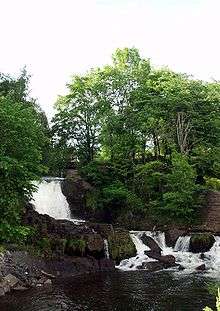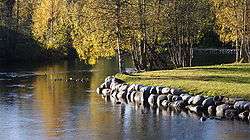Akerselva
| Akerselva Akerselven | |
|---|---|
 "Møllerfossene" in Akerselva | |
| Country | Norway |
| Basin | |
| Main source |
Maridalsvannet 149 m (489 ft) |
| River mouth |
Paulsenkaien, Oslofjorden 0 m (0 ft) |
| Physical characteristics | |
| Length | 8.2 km (5.1 mi) |
Akerselva or Akerselven (English: Aker River[1][2]) is a river which flows through Oslo. It starts at Maridalsvannet in Oslomarka, and follows the urban areas Nordre Aker, Sagene, Grünerløkka, Oslo centre and Grønland, whereby it finally ends at Paulsenkaien and Oset in Bjørvika. The river is considered to be a part of the Nordmarkvassdraget, and has the watercourse number 006.Z. The entire river is about 8.2 kilometres (5.1 mi) long, and has a difference in elevation between source and mouth of approximately 149 metres (489 ft).
Earlier, the river gave power to numerous industry companies in Oslo.
Akerselven is "Oslo’s green lung”; many parks and nature trails are to be found by its path, from Grønland to Maridalsvannet. A walk from along Akerselven from the rural Frysja down through the different parts of Oslo all the way down to the city centre is an amazing experience and a walk through the history of Oslo. Salmon run and spawn in the upper part of the river.
Aker River in the 1970s was heavily contaminated after 150 years of industrial and sewage discharges along river. In the 1980s, a local initiative to limit emissions and revive the flora and fauna of the river began.
Early in March 2011, Oslo's water and wastewater department accidentally discharged 6,000 litres (1,600 US gal) of chlorine into the river near its headwaters, rendering the river virtually dead as of 11 March 2011. According to Norwegian Broadcasting Corporation, the discharge occurred at the water treatment plant Oset.[3]
Name

The first element is the genitive case of Aker, the name of the old farm and churchsite that has named several places in Oslo. The last element is the finite form of the noun elv ('river').
The river is considered to be the border between the eastern and the western part of Oslo. In the eastern part people treat the word elv as a feminine noun, so they say elva ('the river'). The westside dialect is influenced by Danish (considered a more appropriate language during the union with Denmark), where the feminine and masculine genders have merged into a common gender inflected like Norwegian masculine nouns. Therefore, people in the western part often treat elv as a masculine noun, causing them to say elven ('the river').
The Old Norse name of the river was Frysja, and this old name has been revived as the name of a neighborhood along the river. The name is probably derived from the verb frusa 'froth', referring to the many waterfalls in the river.
References
- ↑ Rasch, Tone & Ingebjørg Eidhammer. 2014. Learning through Fashion: The Norwegian Museum of Science and Technology. In Marie Riegels Melchior & Birgitta Svensson (eds.), Fashion and Museums: Theory and Practice, pp. 168–179. London: Bloomsbury, p. 168.
- ↑ Prideaux, Sue. 2007. Edvard Munch: Behind the Scream. New Haven: Yale University Press, p. 19.
- ↑ Akerselva død etter giftutslipp - NRK 8. mars 2011.
Coordinates: 59°54′N 10°45′E / 59.900°N 10.750°E
